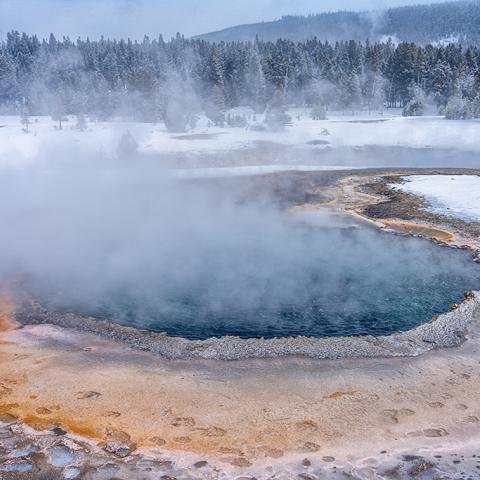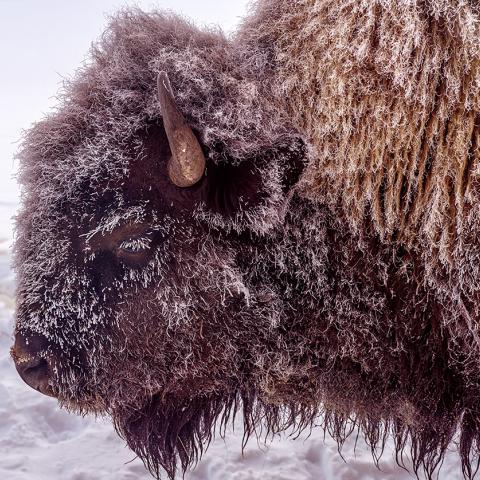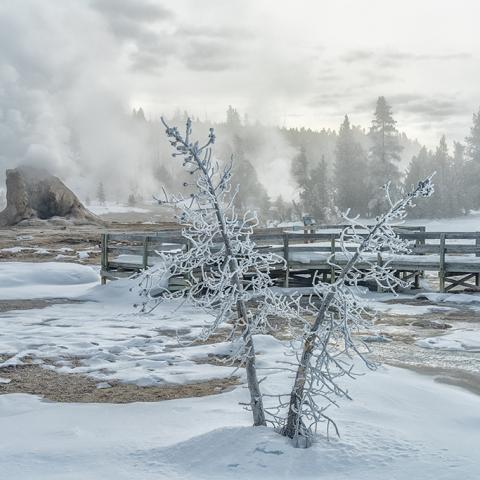A Wolf On The Road In Yellowstone National Park

You never know when serendipity will strike and you might see a lone wolf padding on the snowy road past your snowcoach.
- By Rebecca Latson - March 26th, 2022 4:00am
Help power the National Parks Traveler’s coverage of national parks and protected areas.

You never know when serendipity will strike and you might see a lone wolf padding on the snowy road past your snowcoach.

Nothing says "Yellowstone" like an image of bison grazing on hilly land with tall, rugged, snow-dusted mountains in the background.

"This nearly constant performer splashes from several vents and its steam can be seen throughout the Lower Geyser Basin. Its name is Greek for water clock, and was given because the geyser used to erupt regularly every three minutes. Since the 1959 Hebgen earthquake, however, Clepsydra erupts almost without pause."

During the winter, all roads are closed to personal vehicles, except for the road between the north and northeast entrances. To see the wonders of such places as Porcelain Basin, visitors to the park can reserve a seat on a snowcoach or snowmobile tour.

"With temperatures that average temperate of 191.1°F (88.4°C), Crested Pool is almost constantly boiling, sometimes to 6 feet (2 m) or more. The extreme heat prevents most bacterial growth, resulting in exceptionally clear blue water. Boiling is particularly active along the intricate sinter formation circling the spring, the “crested” edge. Listen for the sizzling. Crested Pool has an average pH of 8.9 and an average conductivity of 2269 uS/cm."

According to the National Park Service, there are about 5,450 bison as of 2021, which includes two primary breeding herds (Northern and Central). You can see them year-round in both the Hayden and Lamar valleys. In the winter, they may be seen near thermal features around the park, including Upper Geyser Basin, Biscuit Basin, and Mammoth, as well as along the Firehole River, Madison River, Blacktail Deer Plateau, Tower, and the Gardiner Basin. The average male weighs 2,000 pounds and the female weighs 1,000 pounds.


Winter in Yellowstone is a magical season and presents yet another side of this park's personality. "Giant Geyser became dormant in 1955. Since then, it has slowly become active and erratic. During 2007, it erupted more than 50 times. During 2010, it erupted once. Its spectacular eruptions last more than an hour and can reach 250 feet (76 m). Before and during eruptions, small geysers on the same platform may erupt."

If you get up early enough in the mornings, you might be able to watch (and photograph) some stunning sunrises in Yellowstone.

Located within the Lower Geyser Basin, "Great Fountain Geyser experiences periods of irregularity. For the most part, it is dependable. Eruptions average 100 feet (31 m) high, with some rare “superbursts” of 200 feet (61 m) or more. Eruptions last 45-60 minutes in a series of bursts. Great Fountain Geyser takes 10-14 hours to rebuild to an eruption. The pool slowly fills, then begins to overflow 70-100 minutes before the eruption."


National Parks Traveler is a 501(c) (3) nonprofit.


Here’s the definitive guide to National Park System campgrounds where RVers can park their rigs.
Our app is packed with RVing- specific details on more than 250 campgrounds in more than 70 national parks.
You’ll also find stories about RVing in the parks, tips helpful if you’ve just recently become an RVer, and useful planning suggestions.
